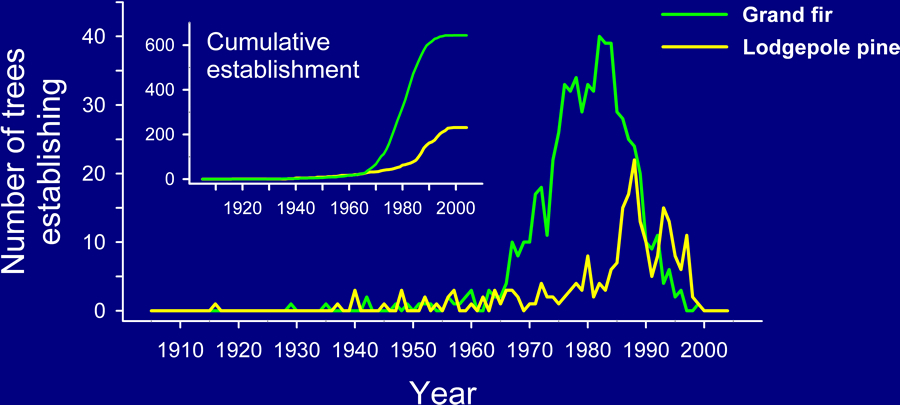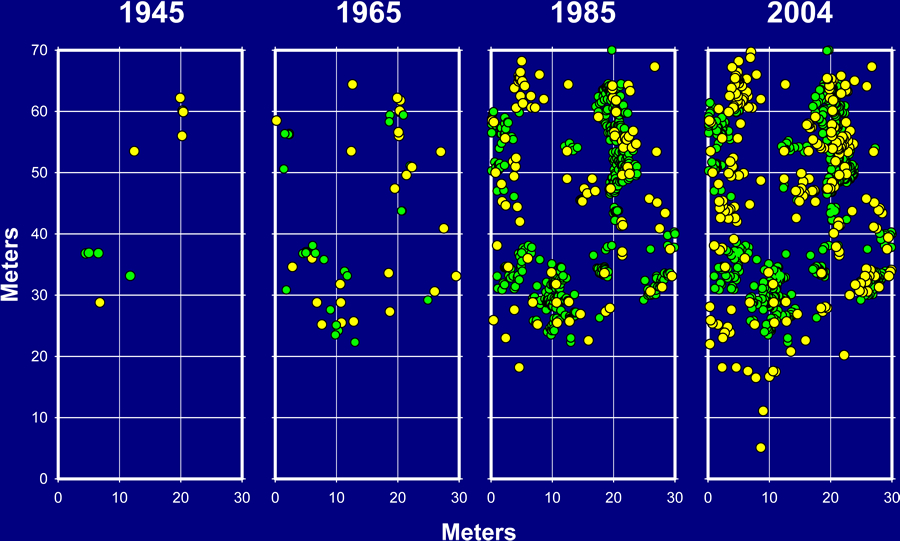| |
From
the dissertation of

Janine
Rice |
|
|
| Results |
|
Timing
of establishment. Trees
first established in the study plot in 1916 (pine) and 1929 (grand
fir), but recruitment remained low for many decades (figure, below).
Grand fir establishment increased markedly in the late 1960s, peaked
in 1983, then declined abruptly. Recruitment of lodgepole pine increased
more slowly, peaked later (1988), then declined. In 2004, densities
of live grand fir and lodgepole pine were 3,067 and 1,100 ha-1,
respectively.
| Age
structure |
 |
| Age
structure of grand fir and lodgepole pine (>0.3 m tall).
Cumulative establishment is also shown. |
|
|
|
| Relationships
with climate and cone production. Tree
establishment in both species showed very weak relationships with
climate and no relationship with annual cone production which showed
a strong 2- to 3-yr cycle.
However,
trends in recruitment were consistent with species’ environmental
tolerances: lodgepole pine tended to establish in years with warmer
early- and late-summer temperatures and grand fir, in years with
wetter springs. Spatio-temporal
patterns of tree establishment. Although
clustering was pervasive, lodgepole pine and grand fir contributed
in contrasting ways to the pace and spatial structure of invasion.
Shade-intolerant Pinus tended to establish in the open (>2
m from nearest neighbors), initiating clumps. Shade-tolerant Abies
was strongly associated with previous establishment (of both species)
leading to rapid, high-intensity clustering.
| Temporal
sequence of establishment |
 |
| Trees
are shown at four points in the invasion process process,
including dates before (1945, 1965), during (1985), and
after (2004) the period of high-density establishment.
• grand
fir, • lodgepole
pine. |
|
|
 |
| Conclusions
Variation
in climate contributed minimally to tree invasion. Both species
established during a period of changing climate, but establishment
was not synchronous with these changes, or with strong cyclical
patterns of seed production.
Differences
in the pace of invasion of grand fir and lodgepole pine may relate,
however, to differences in the spatial availability of seeds. For
both species, onset of establishment coincided with maturation (seed
production) of trees that had invaded adjacent meadows 20-40 years
earlier (also see Spatial
and temporal patterns). The more rapid increase in grand fir
is consistent with its much greater density in these source areas
and its lighter, more readily dispersed seed. The lag in pine is
consistent with its lower density and heavier seed; abundant establishment
in the study plot may not have been possible until initial colonists
achieved reproductive maturity.
Clustering
was rapid and intense for shade-tolerant grand fir, but slower and
less pronounced for lodgepole pine. Younger grand fir were also
positively associated with pine, but younger pine were not associated
with grand fir.
In
sum, our analyses suggest that intrinsic factors have been far more
important to the invasion process than have extrinsic factors. Although
changes in climate or disturbance regime can initiate invasions,
biotic interactions can accelerate the process, enhancing establishment
even when climatic conditions are not optimal.
| Rice,
J. M., C. B. Halpern, J. A. Antos, and J. A. Jones. 2012. Spatio-temporal patterns of tree establishment are indicative
of biotic interactions during early invasion of a montane
meadow. Plant Ecology 213:555-568. Request reprint |
|
 |
 Introduction
& methods
Introduction
& methods |
 |
|
![]()
![]()
![]()
![]()


